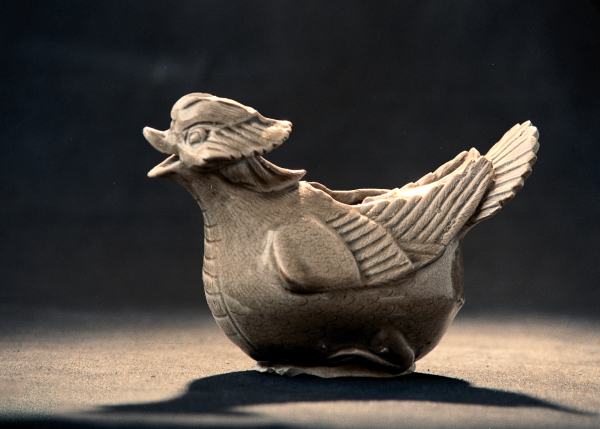It was in 2004 that I visited the excavation site at Dayuanping where archaeologists were exploring the remains of two ancient dragon kilns. The archaeological project was drawing to its end. Dayuanping is in Shangpu Town, Shangyu, which is now a district of Shaoxing in eastern Zhejiang.
The discoveries from the site caused a sensation among archaeologists and celadon experts in the province for two major reasons.

First, the two dragon kilns date back to the last decades of the Eastern Han (25-220AD). A 40-centimeter-thick layer of celadon shards at the Dayuanping site indicates that the shards are from a full range of celadon utensils seen at all other Eastern Han kiln sites. The clay bodies and glazes suggest a fine craftsmanship rarely seen anywhere else. The clay bodies are solid and give clear and clean sounds when tapped lightly. Glazes on the clay bodies are smooth, bright and clean. The decorative patterns on these shards are an encyclopedia on the celadon designs of the period. In fact, the ancient kilns at Dayuanping represent the best celadon kilns of the era in terms of advanced technology and full function. The celadon shards unearthed there represent the best quality and best range of utensils and best patterns ever seen in the period. The kilns at Dayuanping and two adjacent ancient kiln sites were placed under the national governmental protection in May 2006.

Secondly, the firing technique used at the celadon kilns at Dayuanping explains why the site is so important. Dragon kiln number one, truncated by disuse, damage, and time, is 6.36 meters long and 1.80 meters wide. The fire chamber, the ware chamber, and the chimney pit are well preserved. It is estimated that the original dragon kiln was about 13 meters long. The dragon kiln of this scale and structure represented the best technology of the time. Generally, dragon kilns were able to raise firing temperatures to 1,100 to 1,200 degrees Celsius. The standing kiln and the bun-shaped kiln could only achieve a temperature of 800 to 900 degrees Celsius. Studies indicate that dragon kiln number one at Dayuanping could operate at a temperature of 1,300 degrees Celsius. The higher temperature, as testified by the dragon kiln, made the difference.
The visit to Dayuanping opened my eyes to the ancient kilns in Shangyu and enabled me to understand the importance of these kilns in the history of porcelain making in Zhejiang.

Researches indicate that the pottery which emerged in the Neolithic Age became primitive celadon in the Shang (c. 1,600-1,046 BC) and the Zhou dynasties (1046-221 BC). In the Eastern Han, porcelain making became advanced as porcelain clay, utensil shapes, and glazes became better. Dragon kilns revolutionized porcelain making. During the middle period of the Eastern Han, kilns in present-day Shangyu were able to produce exquisite celadons.
The porcelain making industry boomed, replacing the pottery and primitive celadons. The technology and products spread to four corners of the country and reached overseas. Now we know the names and sites of at least 158 kilns in Shangyu that existed from the Eastern Han to the Northern Song Dynasty (960-1127).

It was no accident that celadon took shape in Shangyu in the middle period of the Eastern Han. Shangyu was in the heartland of Hemudu Culture, which flourished (5,500BC to 3,300BC) just south of the Hangzhou Bay in Zhejiang Province. In the late period of the Neolithic Age, pottery making was abundant in the region thanks to rich resources made available by rivers that crossed Shangyu.
No one knows exactly how the first dragon kiln appeared in the history, but local enthusiasts never hesitated to create a story to explain the turning point in the history of porcelain making. I heard a folktale from an old man in his 80s during a field study. According to the old man, a young master was inspired by a dragon-like cloud surging out of a valley during a storm and instantly knew exactly what to do. He built a dragon kiln stretching long upward on a hill slope. The dragon kiln produced the finest porcelain never seen before. It is hard to say whether the revolutionary technology appeared thanks to an epiphany on a stormy day or took form painstakingly bit by bit due to efforts made by craftsmen for better productivity and quality over a long period of time.
